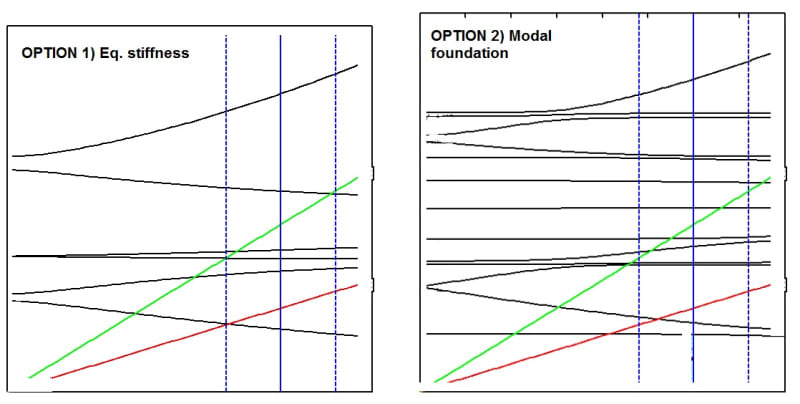Hy everyone,
Since I am new to rotordynamics excuse my probably trivial question:
I am trying to analyze the rotordynamics of a rotor assembly made of Turbine disk - Shaft - Tonewheel.
This assembly is constrained to a machine+foundation assembly through 4 bearings.
The idea is to check if resonance is avoided through a Campbell diagram.
In order to build the Campbell diagram I am using a rotordynamics finite element (mostly unknown) software (RAFT).
As first approximation I have modelled only the rotor with bearings stiffness without considering the machine+foundation stiffness.
With this first model I have obtained a good agreement in terms of natural frequencies at 0 rpm speed with SolidWorks simulation results.
To improve the model accuracy I have decided to consider the machine+foundation stiffness that can be done in two ways:
1) calculate with SW simulation the stiffness of machine+foundation and apply it as equivalent serie stiffness (1/Keq = 1/Kbearings + 1/Km+f)
2) calculate with SW simulation the natural frequencies and vibration modes of machine+foundation and apply them as modal foundations.
Option 1) provided me a clean Campbell diagram with forward and backward modes of the rotor assembly.
Option 2) instead provided me a more complicated diagram with not only the forward and backward modes of the rotor but also the modes of the machine+foundation (see fig. attached, graphs are on the same scale).
Opt 2 highlights more possible resonance at the operating speed.
The rotor natural frequencies of the two options are also slightly different, why?
The question is: shall I consider option 1) or 2) in terms of campbell diagram?
Depending on your experience which solution provides more accurate results?
Thank you for your help

Since I am new to rotordynamics excuse my probably trivial question:
I am trying to analyze the rotordynamics of a rotor assembly made of Turbine disk - Shaft - Tonewheel.
This assembly is constrained to a machine+foundation assembly through 4 bearings.
The idea is to check if resonance is avoided through a Campbell diagram.
In order to build the Campbell diagram I am using a rotordynamics finite element (mostly unknown) software (RAFT).
As first approximation I have modelled only the rotor with bearings stiffness without considering the machine+foundation stiffness.
With this first model I have obtained a good agreement in terms of natural frequencies at 0 rpm speed with SolidWorks simulation results.
To improve the model accuracy I have decided to consider the machine+foundation stiffness that can be done in two ways:
1) calculate with SW simulation the stiffness of machine+foundation and apply it as equivalent serie stiffness (1/Keq = 1/Kbearings + 1/Km+f)
2) calculate with SW simulation the natural frequencies and vibration modes of machine+foundation and apply them as modal foundations.
Option 1) provided me a clean Campbell diagram with forward and backward modes of the rotor assembly.
Option 2) instead provided me a more complicated diagram with not only the forward and backward modes of the rotor but also the modes of the machine+foundation (see fig. attached, graphs are on the same scale).
Opt 2 highlights more possible resonance at the operating speed.
The rotor natural frequencies of the two options are also slightly different, why?
The question is: shall I consider option 1) or 2) in terms of campbell diagram?
Depending on your experience which solution provides more accurate results?
Thank you for your help

